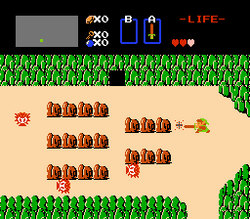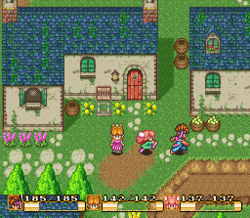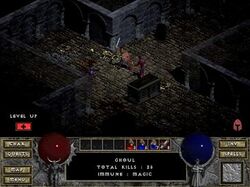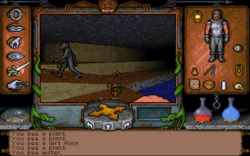Action role-playing game
Action role-playing video games (abbreviated action RPG or ARPG) are a subgenre of role-playing video games. The games emphasize real-time combat where the player has direct control over the characters as opposed to turn or menu-based combat. These games often use action game combat systems similar to hack and slash or shooter games. Action role-playing games may also incorporate action-adventure games, which include a mission system and RPG mechanics, or massively multiplayer online role-playing games (MMORPGs) with real-time combat systems.
Early history
Allgame listed the following games released prior to 1984 as action RPGs: Temple of Apshai (1979)[1] and its sequel Gateway to Apshai (1983),[2] Beneath the Pyramids for the Apple II (1980),[3] Bokosuka Wars (1983),[4] and Sword of Fargoal (1983).[5] Jeremy Parish of USgamer claimed that Adventure (1980) was an action RPG.[6] Bill Loguidice and Matt Barton claimed that the Intellivision games Advanced Dungeons & Dragons (1982) and Treasure of Tarmin (1983) were action RPGs.[7] Shaun Musgrave of TouchArcade notes that Adventure lacked RPG mechanics such as experience points and permanent character growth, and argues that Gateway to Apshai is "the earliest game I'd feel comfortable calling an action-RPG" but notes that "it doesn't fit neatly into our modern genre classifications," though came closer than Bokosuka Wars released the same year.[8]
Jeremy Parish of 1UP.com argues that Japanese developers created a new brand of action role-playing game; these new Japanese games combined the role-playing genre with arcade-style action and action-adventure elements.[9] Shaun Musgrave of TouchArcade also traces the genre's roots to Japan, noting that the "Western game industry of the time had a tendency to treat action games and RPGs as separate things for separate demographics".[8]
Jeremy Parish argues that action RPGs were popularized in Japan by The Tower of Druaga.[9] It was released for arcades in June 1984, and was intended as a "fantasy version of Pac-Man, with puzzles to solve, monsters to battle, and hidden treasure to find".[8] Its success in Japan inspired the development of Dragon Slayer (1984)[9] and Hydlide (1984).[8] Dragon Slayer, Hydlide and Courageous Perseus (1984) "vie for position as genre precedent" according to John Szczepaniak, and there was an ongoing rivalry developing between the Dragon Slayer and Hydlide series over the years.[10] The Tower of Druaga, Dragon Slayer and Hydlide were influential in Japan, where they influenced later action RPGs such as Ys, as well as The Legend of Zelda.[11]:38[12]
Falcom's Dragon Slayer, created by Yoshio Kiya,[12] is "the very first action-RPG ever made" according to GameSetWatch.[13] Originally released for the PC-8801 computer in September 1984,[14] it abandoned the command-based battles of earlier role-playing games in favor of real-time hack-and-slash combat that required direct input from the player, alongside puzzle-solving elements.[12] In contrast to earlier turn-based roguelikes, Dragon Slayer was a dungeon-crawl role-playing game using real-time, action-oriented combat,[13] combined with traditional role-playing mechanics.[9] Dragon Slayer's overhead action role-playing formula was used in many later games.[15]

T&E Soft's Hydlide, released in December 1984,[16] was created by Tokihiro Naito, who was influenced by The Tower of Druaga.[11]:42–49 It was the first action RPG with an overworld.[8] The game was immensely popular in Japan, selling 2 million copies across all platforms.[17] According to John Szczepaniak, it "cannot be overstated how influential Hydlide was on the ARPGs which followed it".[10] The same year, Courageous Perseus was also one of the earliest action RPGs.[18]
Dragon Slayer II: Xanadu, released in 1985 (billed as a "new type of real-time role-playing game"), was an action role-playing game including many character stats and a large quest.[13] It also incorporated a side-scrolling view during exploration and an overhead view during battle,[15] and an early "Karma" morality system where the character's Karma meter will rise if he commits sin (killing "good" enemies), which in turn causes the temples to refuse to level him up.[13] Xanadu Scenario II, released in 1986, was an expansion pack, created to expand the content of Dragon Slayer II: Xanadu.[15] Hydlide II: Shine of Darkness (1985) also featured a morality system.[8] Eurogamer cites Fairlight (1985) as an early action RPG.[19]
Late 1980s

An important influence on the action RPG genre was the 1986 action-adventure, The Legend of Zelda, which served as the template for many future action RPGs.[20] In contrast to previous action RPGs, such as Dragon Slayer and Hydlide, which required the player to bump into enemies in order to attack them, The Legend of Zelda featured an attack button that animates a sword swing or projectile attack on the screen.[12][21] It was also an early example of open-world, nonlinear gameplay, and introduced new features such as battery backup saving. These elements have been used in many action RPGs since.[22]
In 1987, Zelda II: The Adventure of Link implemented a more traditional RPG-esque system, including experience points and levels with action game elements.[23] Unlike its predecessor, Zelda II more closely fits the definition of an action RPG.[8]
Another Metroidvania-style action RPG released that year was System Sacom's Sharp X1 computer game Euphory, which was possibly the only Metroidvania-style multiplayer action RPG produced, allowing two-player cooperative gameplay.[24] The fifth Dragon Slayer title, Sorcerian, was also released that year. It was a party-based action RPG, with the player controlling a party of four characters at the same time in a side-scrolling view. The game also featured character creation, highly customizable characters, class-based puzzles, and a new scenario system, allowing players to choose from 15 scenarios, or quests, to play through in the order of their choice. It was also an episodic video game, with expansion disks later released offering more scenarios.[12] Falcom also released the first installment of its Ys series in 1987. While not very popular in the West, the long-running Ys series has performed strongly in the Japanese market, with many sequels, remakes and ports in the decades that followed its release. Besides Falcom's own Dragon Slayer series, Ys was also influenced by Hydlide, from which it borrowed certain mechanics such as health-regeneration.[25]
The Faery Tale Adventure offered one of the largest worlds at the time, with over 17,000 computer screens without loading times.[26]
In 1988, Telenet Japan's Exile series debuted, and was controversial due to its plot, which revolves around a time-traveling Crusades-era Syrian assassin who assassinates various religious/historical figures as well as 20th century political leaders,[27] The gameplay of Exile included both overhead exploration and side-scrolling combat, and featured a heart monitor to represent the player's Attack Power and Armor Class statistics. Another controversial aspect of the game involved taking drugs (instead of potions) that increase/decrease attributes, but with side effects such as heart-rate increase/decrease or death.[27] Origin Systems, the developer of the Ultima series, also released an action RPG in 1988, titled Times of Lore, which was inspired by various NES titles, particularly The Legend of Zelda.[28]:182, 212 Times of Lore inspired several later titles by Origin Systems, such as the 1990 games Bad Blood (another action RPG based on the same engine)[28]:183 and Ultima VI: The False Prophet, based on the same interface.[29]:83–84
Also in 1989, the enhanced remake Ys I & II was one of the first video games to use CD-ROM, which was utilized to provide enhanced graphics, animated cut scenes,[30][31] a Red Book CD soundtrack,[32][31] and voice acting.[30][32] Its English localization was also one of the first to use voice dubbing. The game received the Game of the Year award from OMNI Magazine in 1990, as well as other prizes.[30] Another 1989 release, Activision's Prophecy: The Fall of Trinadon, attempted to introduce "Nintendo-style" action combat to North American computer role-playing games.[33]
1990s
In 1991, Square released Seiken Densetsu: Final Fantasy Gaiden, also known as Final Fantasy Adventure or Mystic Quest in the West, for the Game Boy. Like Crystalis, the action in Seiken Densetsu bore a strong resemblance to that of Legend of Zelda, but added more RPG elements. It was one of the first action RPGs to allow players to kill townspeople, though later Mana games removed this feature.[34] Arcus Odyssey by Wolf Team (now Namco Tales Studio) was an action RPG that featured an isometric perspective and co-operative multiplayer gameplay.[35]

In 1993, the second Seiken Densetsu game, Secret of Mana, received considerable acclaim,[36] for its innovative pausable real-time action battle system,[37] and its innovative cooperative multiplayer gameplay,[36] where the second or third players could drop in and out of the game at any time, rather than players having to join the game at the same time.[38] The game has remained influential through to the present day, with its ring menu system still used in modern games and its cooperative multiplayer mentioned as an influence on games such as Dungeon Siege III (2011).[38]
Most other such games, however, used a side-scrolling perspective typical of beat 'em ups, such as the Princess Crown series, including Odin Sphere and Muramasa: The Demon Blade.[citation needed]
LandStalker's 1997 spiritual successor Alundra[39] is considered "one of the finest examples of action/RPG gaming", combining platforming elements and challenging puzzles with an innovative storyline revolving around entering people's dreams and dealing with mature themes.[40]
Other subgenres
First-person dungeon crawl
In late 1987, FTL Games released Dungeon Master, a dungeon crawler that had a real-time game world and some real-time combat elements (akin to Active Time Battle), requiring players to quickly issue orders to the characters, setting the standard for first-person computer RPGs for several years.[28]:234–236 It inspired many other developers to make real-time dungeon crawlers, such as Eye of the Beholder and Lands of Lore: The Throne of Chaos.
Ultima Underworld: The Stygian Abyss, released in 1992, has been cited as the first RPG to feature first-person action in a 3D environment.[41] Ultima Underworld is considered the first example of an immersive sim, a genre that combines elements from other genres to create a game with strong player agency and emergent gameplay, and has influence many games since its release.[42] The game's influence has been found in BioShock (2007),[43] and that game's designer, Ken Levine, has stated that "all the things that I wanted to do and all the games that I ended up working on came out of the inspiration I took from [Ultima Underworld]".[44] Gears of War designer Cliff Bleszinski also cited it as an early influence, stating that it had "far more impact on me than Doom".[45] Other games influenced by Ultima Underworld include The Elder Scrolls: Arena,[46] Deus Ex,[47] Deus Ex: Invisible War,[48] Vampire: The Masquerade – Bloodlines,[49] and Half-Life 2.[50] Toby Gard stated that, when designing Tomb Raider, he "was a big fan of ... Ultima Underworld and I wanted to mix that type of game with the sort of polygon characters that were just being showcased in Virtua Fighter."[51] Ultima Underworld was also the basis for Looking Glass Technologies' later System Shock.[52]
The engine was re-used and enhanced for Ultima Underworld's 1993 sequel, Ultima Underworld II: Labyrinth of Worlds.[53] Looking Glass Studios planned to create a third Ultima Underworld, but Origin rejected their pitches.[54] After Electronic Arts (EA) rejected Arkane Studios' pitch for Ultima Underworld III, the studio instead created a spiritual successor: Arx Fatalis.[55]
Point and click
File:Freedroidrpg basic gameplay.ogv Action RPGs were far more common on consoles than computers, due to gamepads being better suited to real-time action than the keyboard and mouse.[56]:43 Though there were attempts at creating action-oriented computer RPGs during the late 1980s and early 1990s, very few saw any success.[56]:43 Times of Lore was one of the more successful attempts in the American computer market,[56]:43 where there was a generally negative attitude towards combining genres in this way and more of an emphasis on preserving the purity of the RPG genre.[9] For example, a 1991 issue of Computer Gaming World criticized several computer role-playing games for using "arcade" or "Nintendo-style" action combat, including Ys, Sorcerian, Times of Lore, and Prophecy.[33]

The 1988 Origin Systems title Times of Lore was an action RPG with an icon-based point-and-click interface. Bad Blood, another Origin Systems game from 1990, would use the same interface.[57] The designers were inspired by console titles, particularly The Legend of Zelda, to make their interface more accessible.[58]
The 1994 title Ultima VIII used mouse controls and attempted to add precision jumping sequences reminiscent of a Mario platform game, though reactions to the game's mouse-based combat were mixed. In 1996 Blizzard's Diablo was released and became massively successful. It was an action RPG that used a point-and-click interface and offered gamers a free online service to play with others that maintained the same rules and gameplay.[56]:43
Diablo's effect on the market was significant, inspiring many imitators. Its impact was such that the term "action RPG" has come to be more commonly used for Diablo-style games rather than Zelda-style games, with The Legend of Zelda itself recategorized as an action-adventure.[9]
Role-playing shooter
Shooter-based action RPGs include Strife (1996), System Shock 2 (1999), the Deus Ex series (2000 onwards) by Ion Storm, Bungie's Destiny (2014), Irem's Steambot Chronicles (2005),[59] Square Enix's third-person shooter RPG Dirge of Cerberus: Final Fantasy VII (2006), which introduced an over-the-shoulder perspective similar to Resident Evil 4,[60] and the MMO vehicular combat game Auto Assault (2006) by NetDevil and NCsoft.[61] Other action RPGs featured both hack and slash and shooting elements, with the use of both guns (or in some cases, bow and arrow or aerial combat) and melee weapons, including Cavia's flight-based Drakengard series (2003 to 2005),[62] and Level-5's Rogue Galaxy (2005).[63]
Other RPS games include the Mass Effect series (2007 onwards), Fallout 3 and subsequent Fallout titles (2008 onwards), White Gold: War in Paradise (2008), and Borderlands (2009).[64] Borderlands developer Gearbox software has dubbed it as a "role-playing shooter" due to the heavy RPG elements within the game, such as quest-based gameplay and also its character traits and leveling system.[65] Half-Minute Hero (2009) is an RPG shooter featuring self-referential humour and a 30-second time limit for each level and boss encounter.[66] Other recent action role-playing games with shooter elements include the 2010 titles Alpha Protocol by Obsidian Entertainment and The 3rd Birthday, the third game in the Parasite Eve series, features a unique blend of action RPG, real-time tactical RPG, survival horror and third-person tactical shooter elements.[67][68]
More recent shooter-based RPGs include Imageepoch's post-apocapytic Black Rock Shooter (2011), which employs both first-person and third-person shooter elements,[69][70] and Square Enix's Final Fantasy XV (2016), which features both hack and slash and third-person shooter elements.[71]
References
- ↑ Temple of Apshai[|permanent dead link|dead link}}] at AllGame
- ↑ Gateway to Apshai[|permanent dead link|dead link}}] at AllGame
- ↑ Beneath the Pyramids[|permanent dead link|dead link}}] at AllGame
- ↑ Bokosuka Wars[|permanent dead link|dead link}}] at AllGame
- ↑ Sword of Fargoal[|permanent dead link|dead link}}] at AllGame
- ↑ Jeremy Parish (2014). "Montezuma's Revenge, an Atari Quest to Make Adventure Proud". http://www.usgamer.net/articles/montezumas-revenge-an-adventure-to-make-adventure-proud. Retrieved 2017-10-18. "By borrowing from Atari's action RPG, Utopia created a platformer classic."
- ↑ Barton, Matt; Loguidice, Bill (2008). "A History of Gaming Platforms: Mattel Intellivision". https://www.gamasutra.com/view/feature/132054/a_history_of_gaming_platforms_.php?page=7. Retrieved 2017-10-18. "Mattel's lineup included the classic action role-playing games Advanced Dungeons & Dragons Cartridge (1982) and Advanced Dungeons & Dragons Treasure of Tarmin Cartridge (1983)."
- ↑ 8.0 8.1 8.2 8.3 8.4 8.5 8.6 Musgrave, Shaun (2017-07-13). "RPG Reload Glossary: The Origins of Action-RPGs". http://toucharcade.com/2017/07/13/rpg-reload-glossary-the-origins-of-action-rpgs/.
- ↑ 9.0 9.1 9.2 9.3 9.4 9.5 Jeremy Parish (2012). "What Happened to the Action RPG?". Archived from the original on 2015-01-12. https://archive.today/20150112012702/http://www.1up.com/features/what-happened-action-rpg.html. Retrieved 2015-01-14.
- ↑ 10.0 10.1 Szczepaniak, John (2015). The Untold History of Japanese Game Developers Volume 2. CreateSpace Independent Publishing Platform. pp. 38. ISBN 9781518818745. "It cannot be overstated how influential Hydlide was on the ARPGs which followed it, nor how popular it was on both computers and the Famicom in Japan. But it is imperative you compare Hydlide only to games released that same year, to fully appreciate the merit in its ideas. There were two other similar titles in 1984, Courageous Perseus and Dragon Slayer, and all three vie for position as genre precedent – amusingly, a friendly rivalry even developed with Dragon Slayer's creator Yoshio Kiya, of Falcom, as over the years T&E Software and Falcom competed against each other."
- ↑ 11.0 11.1 Szczepaniak, John (2015). The Untold History of Japanese Game Developers Volume 2. CreateSpace Independent Publishing Platform. ISBN 9781518818745.
- ↑ 12.0 12.1 12.2 12.3 12.4 Kalata, Kurt. "Dragon Slayer". Hardcore Gaming 101. Archived from the original on 2011-07-23. https://web.archive.org/web/20110723142515/http://www.hardcoregaming101.net/dragonslayer/dragonslayer.htm. Retrieved 2016-07-23.
- ↑ 13.0 13.1 13.2 13.3 "Falcom Classics". GameSetWatch. July 12, 2006. http://www.gamesetwatch.com/2006/07/column_compilation_catalog_fal_1.php. Retrieved 2011-05-18.
- ↑ Falcom Chronicle, Nihon Falcom
- ↑ 15.0 15.1 15.2 Kalata, Kurt. "Xanadu". Hardcore Gaming 101. Archived from the original on 23 July 2011. https://web.archive.org/web/20110723142521/http://www.hardcoregaming101.net/xanadu/xanadu.htm. Retrieved 2011-09-07.
- ↑ "Hydlide (PC88)". http://www.famitsu.com/cominy/?m=pc&a=page_h_title&title_id=28193. Retrieved 2015-01-14.
- ↑ "History of Japanese Video Games". Kinephanos. http://www.kinephanos.ca/2015/history-of-japanese-video-games/. Retrieved 2016-07-23.
- ↑ Szczepaniak, John (2015). The Untold History of Japanese Game Developers Volume 2. CreateSpace Independent Publishing Platform. ISBN 9781518818745. "Courageous Perseus is one of the earliest if not the first Action-RPG"
- ↑ Mason, Graeme (July 24, 2016). "The classic 8-bit isometric games that tried to break the mould". http://www.eurogamer.net/articles/2016-07-24-the-classic-8-bit-isometric-games-that-tried-to-break-the-mould. Retrieved 2017-10-18. "[T]here were potions and food to collect as well, making Fairlight an early entry in the action RPG genre seen so commonly today."
- ↑ "GameSpy's 30 Most Influential People in Gaming". GameSpy. Archived from the original on 2 March 2007. https://web.archive.org/web/20070302042627/http://archive.gamespy.com/articles/march02/top30/61/index3.shtm. Retrieved 2007-04-01.
- ↑ Kalata, Kurt; Greene, Robert. "Hydlide". Hardcore Gaming 101. http://www.hardcoregaming101.net/hydlide/hydlide.htm.
- ↑ "15 Most Influential Games of All Time: The Legend of Zelda". GameSpot. Archived from the original on 2010-05-15. https://web.archive.org/web/20100515053341/http://www.gamespot.com/gamespot/features/video/15influential/p9_01.html. Retrieved 2010-01-24.
- ↑ Comedy (2006-02-25). "Zelda II: The 20-Year-Late Review". WIRED. https://www.wired.com/gamelife/2006/02/zelda_ii_the_20/. Retrieved 2016-07-23.
- ↑ John Szczepaniak. "Retro Japanese Computers: Gaming's Final Frontier". Hardcore Gaming 101. p. 4. http://www.hardcoregaming101.net/JPNcomputers/Japanesecomputers4.htm. Retrieved 2011-03-18. (Reprinted from Retro Gamer, Issue 67, 2009)
- ↑ Szczepaniak, John (7 July 2011). "Falcom: Legacy of Ys". GamesTM (111): 152–159 [153]. http://imageshack.us/f/32/yshistory02.jpg/. Retrieved 2011-09-07.
- ↑ Horowitz, Ken (8 January 2009). "Genre Spotlight: RPG Round-Up". http://www.sega-16.com/2009/01/genre-spotlight-rpg-round-up/. Retrieved 19 October 2017. "It was hailed at the time as having the largest in-game world of any RPG (almost 17,000 screens)..."
- ↑ 27.0 27.1 Szczepaniak, John (2009-04-11). "Exile / XZR". Hardcore Gaming 101. http://www.hardcoregaming101.net/exile/exile.htm. Retrieved 2009-08-10.
- ↑ 28.0 28.1 28.2 Barton, Matt (2008). Dungeons & Desktops: The History of Computer Role-Playing Games. Wellesley, Massachusetts: A K Peters. ISBN 1568814119. https://books.google.com/books?id=qPPRBQAAQBAJ.
- ↑ "The Official Book Of Ultima". 17 September 1990. https://archive.org/details/TheOfficialBookOfUltima.
- ↑ 30.0 30.1 30.2 Szczepaniak, John (7 July 2011). "Falcom: Legacy of Ys". GamesTM (111): 152–159 [156]. http://imageshack.us/f/35/yshistory05.jpg/. Retrieved 2011-09-08.
- ↑ 31.0 31.1 Szczepaniak, John (July 8, 2011). "History of Ys interviews". Hardcore Gaming 101. http://blog.hardcoregaming101.net/2011/07/history-of-ys-interviews-by-john.html. Retrieved 6 September 2011.)
- ↑ 32.0 32.1 Szczepaniak, John (7 July 2011). "Falcom: Legacy of Ys". GamesTM (111): 152–159 [155]. http://imageshack.us/f/35/yshistory04.jpg/. Retrieved 2011-09-08.
- ↑ 33.0 33.1 Scorpia (October 1991). "C*R*P*G*S / Computer Role-Playing Game Survey". Computer Gaming World: p. 16. http://www.cgwmuseum.org/galleries/index.php?year=1991&pub=2&id=87. Retrieved 18 November 2013.
- ↑ Andrew Vestal (1998-11-02). "Other Game Boy RPGs". GameSpot. Archived from the original on 2011-07-11. https://web.archive.org/web/20110711071821/http://uk.gamespot.com/features/vgs/universal/rpg_hs/gameboy3.html. Retrieved 2009-11-18.
- ↑ Buchanan, Levi (2008-06-17). "Top 10 Renovation Games". IGN.com. http://retro.ign.com/articles/882/882363p1.html. Retrieved 2009-11-06.
- ↑ 36.0 36.1 Dutton, Fred (2010-12-17). "Secret of Mana hits App Store this month •". Eurogamer.net. http://www.eurogamer.net/articles/2010-12-17-secret-of-mana-hits-app-store-this-month. Retrieved 2016-07-23.
- ↑ "Secret of Mana". http://www.rpgfan.com/reviews/secretofmana/Secret_of_Mana-2.html. Retrieved 2016-07-23.
- ↑ 38.0 38.1 May 8, 2011 (2011-05-08). "Obsidian: We Wish New Vegas ‘Wasn’t Glitchy’". NowGamer. Archived from the original on 2011-01-02. https://web.archive.org/web/20110102110139/http://www.nowgamer.com/features/1127/dungeon-siege-iii-developer-interview. Retrieved 2016-07-23.
- ↑ Webber (2 March 1998). "Alundra". RPGFan. http://www.rpgfan.com/reviews/alundra/Alundra.html. Retrieved 20 January 2015.
- ↑ Zimmerman, Conrad (2009-03-20). "An RPG Draws Near! Alundra". Destructoid. http://www.destructoid.com/an-rpg-draws-near-alundra-125565.phtml. Retrieved 30 January 2012.
- ↑ Shahrani, Sam (April 25, 2006). "Educational Feature: A History and Analysis of Level Design in 3D Computer Games (Part 1)". Gamasutra. Archived from the original on June 29, 2006. https://web.archive.org/web/20060629172105/http://gamasutra.com/features/20060425/shahrani_01.shtml. Retrieved February 10, 2009.
- ↑ Wiltshire, Alex (December 15, 2016). "How the Makers of 'System Shock' and 'Ultima Underworld' Rediscovered Their Roots". Glixel. http://www.glixel.com/news/the-makers-of-ultima-underworld-return-to-their-roots-w456304. Retrieved April 17, 2017.
- ↑ Weise, Matthew Jason (February 29, 2008). "Bioshock: A Critical Historical Perspective". Eludamos. Journal for Computer Game Culture 2 (1): 151–155. OCLC 220219478. Archived from the original on March 6, 2008. https://web.archive.org/web/20080306020123/http://www.eludamos.org/index.php/eludamos/article/view/27/40. Retrieved March 8, 2009.
- ↑ Irwin, Mary Jane (December 3, 2008). "'Games Are The Convergence Of Everything'". Forbes. Archived from the original on February 25, 2009. https://web.archive.org/web/20090225110906/http://www.forbes.com/2008/12/03/ken-levine-bioshock-tech-personal-cx_mji_1203levine.html. Retrieved March 17, 2009.
- ↑ Totilo, Stephen (May 22, 2006). "Gaming Roundtable Considers Bloody Monsters". MTV. Archived from the original on March 4, 2010. https://web.archive.org/web/20100304115303/http://www.mtv.com/news/articles/1532185/20060519/story.jhtml. Retrieved March 6, 2009.
- ↑ "Arena: Behind the Scenes". Bethesda Softworks. Archived from the original on December 11, 2007. https://web.archive.org/web/20071211032310/http://www.elderscrolls.com/tenth_anniv/tenth_anniv-arena.htm. Retrieved 2007-09-28.
- ↑ "Warren Spector of Ion Storm (Part Two)". Eurogamer. August 4, 2000. Archived from the original on May 18, 2011. https://web.archive.org/web/20110518105205/http://www.eurogamer.net/articles/warrens2. Retrieved March 6, 2009.
- ↑ Aihoshi, Richard (November 17, 2003). "Deus Ex: Invisible War Interview, Part 1". IGN. Archived from the original on November 19, 2003. https://web.archive.org/web/20031119071038/http://rpgvault.ign.com/articles/440/440693p1.html. Retrieved March 6, 2009.
- ↑ Boyarsky, Leonard (December 13, 2003). "Vampire: The Masquerade – Bloodlines Designer Diary #3". GameSpot. Archived from the original on May 18, 2016. https://web.archive.org/web/20160518130331/http://www.gamespot.com/articles/vampire-the-masquerade-bloodlines-designer-diary-3/1100-6085643/.
- ↑ Reed, Kristan (May 12, 2004). "Half-Life 2 - Valve speaks to Eurogamer". Eurogamer. Archived from the original on January 26, 2010. https://web.archive.org/web/20100126011711/http://www.eurogamer.net/articles/i_e3valvesoftware_pc. Retrieved March 6, 2009.
- ↑ Gibbon, Dave (June 28, 2001). "Q&A: The man who made Lara". BBC. Archived from the original on July 17, 2004. https://web.archive.org/web/20040717173949/http://news.bbc.co.uk/2/hi/entertainment/1410480.stm. Retrieved March 6, 2009.
- ↑ Rouse III, Richard (2005). Game Design: Theory & Practice Second Edition. Wordware Publishing. 500-531. ISBN 1-55622-912-7.
- ↑ "An Interview With Looking Glass Technologies". Game Bytes. 1992. Archived from the original on April 19, 2013. https://web.archive.org/web/20130419201423/http://www.ttlg.com/articles/UW2int2.asp. Retrieved February 15, 2009.
- ↑ Mallinson, Paul (April 16, 2002). "Feature: Games that changed the world: Ultima Underworld". Computer and Video Games. Archived from the original on December 12, 2007. https://web.archive.org/web/20071212192612/http://www.computerandvideogames.com/article.php?id=28003. Retrieved February 10, 2009.
- ↑ Todd, Brett (March 20, 2002). "Arx Fatalis Preview". GameSpot. Archived from the original on November 2, 2010. https://www.webcitation.org/5tw8kwxgf?url=http://www.gamespot.com/pc/rpg/arxfatalis/news.html?sid=2856384&mode=previews&print=1. Retrieved February 9, 2009.
- ↑ 56.0 56.1 56.2 56.3 Loguidice, Bill; Barton, Matt (2009). Vintage Games: An Insider Look at the History of Grand Theft Auto, Super Mario, and the Most Influential Games of All Time. Boston: Focal Press. ISBN 0240811461.
- ↑ "The Official Book Of Ultima". Archive.org. 2010-07-21. https://archive.org/stream/TheOfficialBookOfUltima/The-Official-Book-of-Ultima#page/n95/mode/2up. Retrieved 2017-02-20.
- ↑ Computer Gaming World, issue 68 (February 1990), pages 34 & 38
- ↑ Spencer (2006-05-23). "Steambot Chronicles". Siliconera. http://www.siliconera.com/2006/05/23/steambot-chronicles/. Retrieved 2016-07-23.
- ↑ "Dirge of Cerberus: Final Fantasy VII". Siliconera. http://www.siliconera.com/dirge-of-cerberus-final-fantasy-vii/. Retrieved 2011-03-29.
- ↑ Kaiser, Joe (July 8, 2005). "Unsung Inventors". Next-Gen.biz. Archived from the original on 2005-10-28. https://web.archive.org/web/20051028224610/http://www.next-gen.biz/index.php?option=com_content&task=view&id=336&Itemid=2. Retrieved 2010-04-02.
- ↑ "Drakengard Preview for PS2 from". 1UP.com. http://www.1up.com/previews/drakengard_3. Retrieved 2016-07-23.
- ↑ Yang, Louise (2007-01-26). "Rogue Galaxy: charming and cel shaded". Siliconera. http://www.siliconera.com/2007/01/26/rogue-galaxy-charming-and-cel-shaded/. Retrieved 2016-07-23.
- ↑ "A Visual Guide To The Role-Playing Game". Kotaku.com. 2010-05-25. http://kotaku.com/5546807/a-visual-guide-to-the-role+playing-game. Retrieved 2010-10-25.
- ↑ "Inside Mac Games Review: Borderlands: Game Of The Year Edition". Insidemacgames.com. 2011-01-31. http://www.insidemacgames.com/reviews/view.php?ID=1119. Retrieved 2016-07-23.
- ↑ Keith Stuart (4 March 2011). "2D Forever: the fall and rise of hardcore Japanese game design". The Guardian. https://www.theguardian.com/technology/gamesblog/2011/mar/04/2d-forever-japanese-game-design. Retrieved 2011-03-23.
- ↑ Patrick Kolan (March 25, 2011). "The 3rd Birthday Review: Manhattan just can't catch a break these days". IGN. http://uk.psp.ign.com/articles/115/1157383p1.html. Retrieved 2011-04-01.
- ↑ David Wolinsky (April 7, 2011). "The 3rd Birthday review: New year's Eve". Joystiq. Archived from the original on 4 May 2011. https://web.archive.org/web/20110504024913/http://www.joystiq.com/2011/04/07/the-3rd-birthday-review/. Retrieved 2011-04-09.
- ↑ Tom Goldman (2010-11-24). "Imageepoch Unveils New Wave of JRPGs". The Escapist. http://www.escapistmagazine.com/news/view/105615-Imageepoch-Unveils-New-Wave-of-JRPGs. Retrieved 2016-07-23.
- ↑ Spencer (2010-11-23). "Black Rock Shooter: The Game In Development For PSP [Update: Trailer". Siliconera. http://www.siliconera.com/2010/11/23/black-rock-shooter-the-game-in-development-for-psp/. Retrieved 2016-07-23.
- ↑ "Final Fantasy Versus XIII trailer leaks out – GamerTell". GamerTell. 2011-01-18. http://www.gamertell.com/technologytell/article/final-fantasy-versus-xiii-trailer-leaks-out/. Retrieved 2016-07-23.


